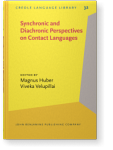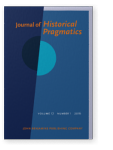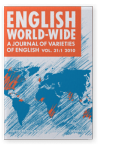Viveka Velupillai
List of John Benjamins publications for which Viveka Velupillai plays a role.
Journals
ISSN 0920-9034 | E-ISSN 1569-9870
ISSN 0378-4177 | E-ISSN 1569-9978
Book series
Titles
Pidgins, Creoles and Mixed Languages: An Introduction
Viveka Velupillai
[Creole Language Library, 48] 2015. xxvii, 599 pp.
Subjects Contact Linguistics | Creole studies | Theoretical linguistics
Subjects Functional linguistics | Typology
Synchronic and Diachronic Perspectives on Contact Languages
Edited by Magnus Huber and Viveka Velupillai
[Creole Language Library, 32] 2007. xii, 370 pp.
Subjects Contact Linguistics | Creole studies | Historical linguistics | Theoretical linguistics
2019 Gendered inanimates in Shetland dialect: Comparing pre-oil and contemporary speech English World-Wide 40:3, pp. 269–298 | Article
The use of gendered pronouns with inanimate noun referents, such as referring to line and pipe as she and to bag or lid as he, has been described as typical for Shetland dialect. In light of recent discussion on the shift from Shetland dialect to Standard English, presumably triggered by the… read more
2016 Partitioning the timeline: A cross-linguistic survey of tense Studies in Language 40:1, pp. 93–136 | Article
This article presents the findings of a cross-linguistic survey of tense. In an areally and genetically balanced sample, 318 languages were investigated for whether they have tense and, if so, how they partition the timeline with respect to the deictic centre. Three quarters of the languages have… read more
2012 Homelands of the world’s language families: A quantitative approach Quantitative Approaches to Linguistic Diversity: Commemorating the centenary of the birth of Morris Swadesh, Wichmann, Søren and Anthony P. Grant (eds.), pp. 57–86 | Article
A systematic, computer-automated tool for narrowing down the homelands of linguistic families is presented and applied to 82 of the world’s larger families. The approach is inspired by the well-known idea that the geographical area of maximal diversity within a language family corresponds to the… read more
2010 Homelands of the world’s language families: A quantitative approach Quantitative Approaches to Linguistic Diversity: Commemorating the centenary of the birth of Morris Swadesh, Wichmann, Søren and Anthony P. Grant (eds.), pp. 247–276 | Article
A systematic, computer-automated tool for narrowing down the homelands of linguistic families is presented and applied to 82 of the world’s larger families. The approach is inspired by the well-known idea that the geographical area of maximal diversity within a language family corresponds to the… read more












